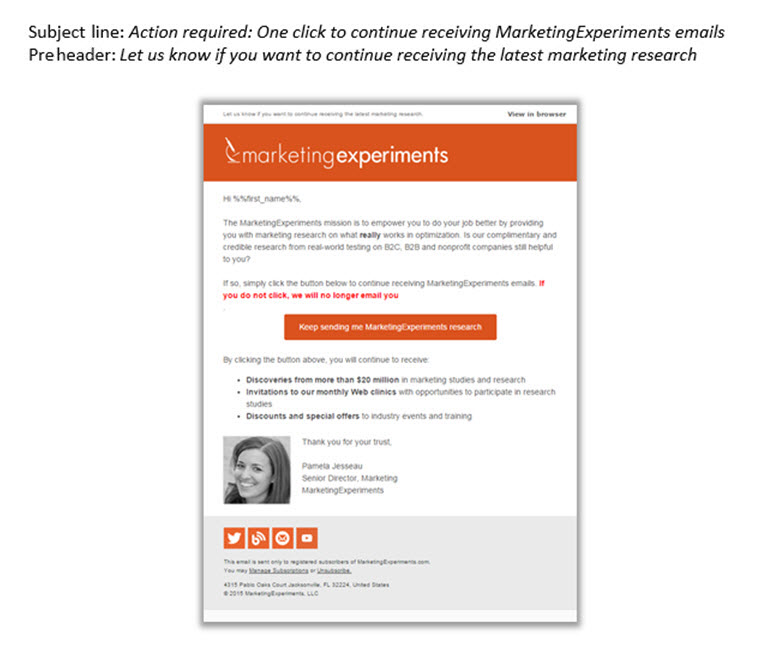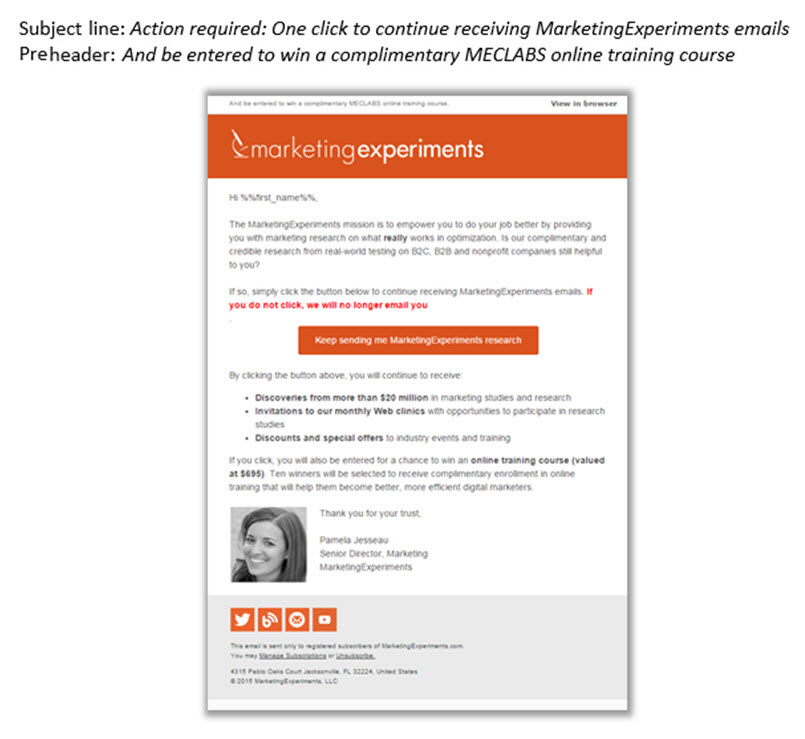If you are reading this, you are likely in one of two positions:
- You have decided it is time to cleanse your email list of the inactive subscribers that no longer engage with your email sends, or …
- You need to stay compliant with your email management software (EMS), and you are being required to send your subscribers a permission pass to keep emailing them. A permission pass is a one-time send to an email list to reconfirm permission to email.
If you are in the latter position, don’t panic. This is actually a good opportunity to clean up your list and increase engagement with your current list.
At MarketingExperiments, our team recently did just that. We sent out a permission pass email to clean our list of inactive subscribers (which only drag down our rates).
We decided to run a test on the permission pass email based off of a previous blog that Daniel Burstein, Director of Editorial Content, MarketingSherpa, wrote back in September for a re-engagement campaign MarketingExperiments implemented after the Canadian Anti-Spam Legislation. While this campaign was not a permission pass, it was similar, and we were able to work off the findings from that campaign to formulate the test discussed in this blog post.
The main objective of the test was to see if subscribers would be more willing to opt back in with us if we offered them an incentive. While discovering that incentives were not valuable to inactive subscribers, our team also uncovered some valuable takeaways that will be quite insightful for any future permission pass sends.
Treatment #1. General Value
Treatment #1 focused on reminding subscribers of the value they would continue to receive with MarketingExperiments.
Treatment #2. General Value and Incentive Offering
Treatment #2 also communicated a reminder of the value subscribers would continue to receive with MarketingExperiments. Additionally, it alerted them that by opting back in with MarketingExperiments, they would be entered to win a free MECLABS online training course.
Note that Treatment #2 did have the same subject line, but it had a different preheader, alerting subscribers of the incentive that was in the email.
Results
When looking at the results of this test, we saw a -10.89% decrease in the number of subscribers opting back in (emails delivered/email clickthrough) for our incentive treatment. In order to fully understand why this occurred, we must dig a bit deeper into the two metrics that affect a permission pass: open rate and clickthrough rate.
When we look at open rate (emails delivered/emails opened), we see the incentive treatment had a 7.01% decrease at a 99% level of confidence. Since our subject lines were identical between treatments, this shows us that our preheader made a significant difference in subscribers opening our email. If a subscriber saw our incentive preheader, they were 7% less likely to open our permission pass email.
Looking at clickthrough rate (emails opened/email clickthrough), we saw no significant difference at all between the two treatments. The only difference in email content was the incentive mention. Since we saw no significant difference in clickthrough, we know that the mention of the incentive within the email made no difference on a subscriber opting back in.
This test taught us that subscribers were highly motivated to opt back in if they opened our email. We know this because the mention of the incentive within our email made no difference on clickthrough. It is likely that many of these subscribers made the decision to opt back in upon reading the subject line of the email alone.
This is interesting because it tells us that the most important aspect of a permission pass send is getting the subscriber to open your email.
If you find yourself sending a permission pass, make sure to provide a strong subject line that immediately hooks your subscriber and alerts them of the action they must take within the email.
A final takeaway from this test is how big of a difference a strong preheader can make. On this test, a preheader alone accounted for a 7% difference in open rate.
You might also like
Email Marketing: Compliance-related re-engagement campaign messaging increases conversion 49% [More from the blogs]
Email Deliverability: Only 39% of marketers maintain an opt-in only subscriber list [More from the blogs]
Email List Hygiene: Remove four kinds of bad addresses to improve deliverability [More from the blogs]








